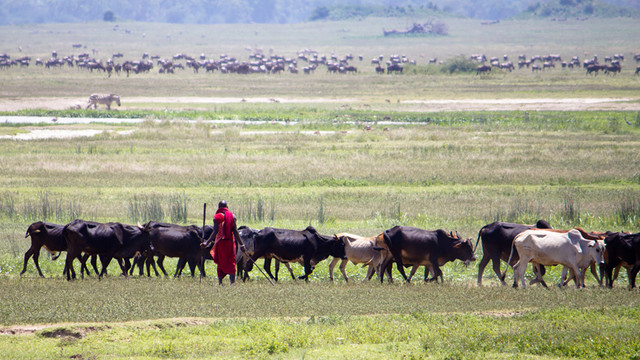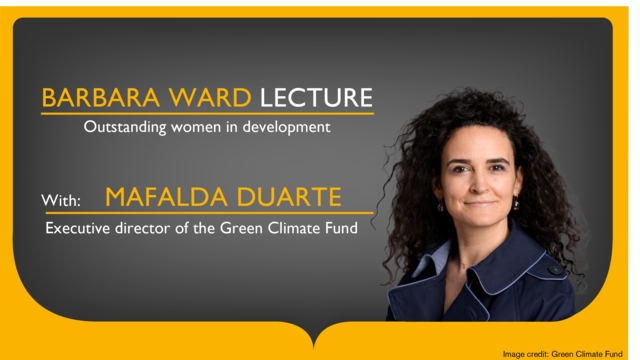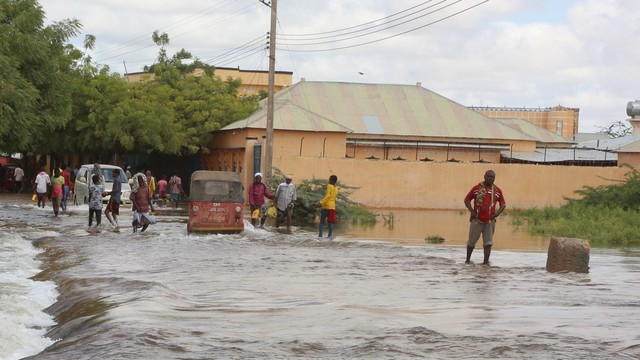What is 'aggregation' and how can it get climate finance working for the most vulnerable?
Climate finance is not being invested at the volume and scale needed to enable vulnerable communities across the world to respond effectively to the impacts of climate change. Sam Greene discusses some of the innovations that are 'aggregating' finance, recipients or information together to help money to flow to where it matters.


This 500W solar system in a rural village in Uganda powers a home, a public broadcasting system, a barbershop and a video hall (Photo: SolarNow via USAID, Creative Commons via Flickr)
Local communities and businesses know what works and have ingenious and sustainable solutions for adapting to climate change. But they are largely cut out of the funding picture, making it challenging for them to access the finance they would need to take solutions to scale.
IIED is exploring the barriers stopping climate finance reaching local people. We are examining emerging technologies and how they can address the barriers that prevent finance from flowing. In particular, we are looking at the potential of new high and low tech innovations that enable finance to flow.
Delivering effective, adequate climate adaptation is an expensive challenge. Some estimates place Africa’s adaptation burden at US$50bn per year under present emission trends. Meeting this challenge will require public sector finance in order to attract the resources and innovative potential of the private sector. Both public and private investment needs to see viable social, environmental and particularly financial returns from scaled up solutions.
Investors are often discouraged by high transaction costs, and the risks of scaling up new projects or innovations in countries with emergent industries, limited technological literacy and poorly connected communities. For example, effective disbursement of loans to smallholder farmers requires investment in local branches and staff, as does rolling out new technologies like solar which require local trained technicians and customer services.
The solution lies in 'aggregation': packaging different elements of the investment chain to increase efficiency. A recent IIED paper identified four types of aggregation:
- Blending different types of finance to reduce the risks of losses – for example blending local savings, government subsidies, concessional finance and private sector capital
- Aggregating the demand for recipients of finance – for example through producer groups, cooperatives or urban poor federations, enabling disaggregation of smaller funds to support adaptation at the very local level
- Pooling information about potential markets or enterprises for investment to enable investors to make quicker and easier decisions about risks and returns
- Bundling smaller enterprises or multiple small projects together for investment, creating platforms that can enable them to collectively access and manage finance – for example through community funding mechanisms
Encouraging examples are emerging that demonstrate the ability of aggregation mechanisms to get finance moving to where it is needed most.
SunFunder, a solar financing business, finances enterprises in the solar supply chain, linking investors to borrowers. Their 'Beyond the Grid' fund blends finance from charitable foundations with a higher tolerance for risk (junior partners) with profit-seeking capital (senior partners) to create an investment fund that is competitive.
The junior partners agree to absorb initial losses so that the remaining senior investors can benefit. SunFunder provide expertise in the solar market, aggregating finance and building long-term relationships with borrowers. Almost $50m of loans have been issued for solar so far to borrowers in emerging markets, benefitting communities distant from centralised power grids.
Producers Direct aggregate demand for finance. Using 'centres of excellence' across East Africa and Latin America, they enable smallholder farmers to access climate smart agricultural techniques, and provide a revolving fund that lets farmers borrow to invest in climate smart farming inputs. An online app called 2Kuze is enabling smallholder farmers to negotiate crop sales with buyers and increase sales, while creating a recorded financial transaction history that can support future loan applications.
While online platforms and apps are valuable tools, aggregation mechanisms depend on relationships that do not involve technology at all. One online aggregation platform for institutional investors, SDG Investments, has found that institutional investors are more likely to create deals with organisations and individual entrepreneurs who are from their own or nearby countries – otherwise they remain sceptical of their ability to control events. On the demand side, community funds or cooperatives are often rooted in relationships between particular villages or groups of villages.
There are challenges. On the demand side, there are not enough investment-ready businesses in vulnerable countries which can deliver adaptation outcomes at scale. Many smaller enterprises find they are too big for microfinance but also seen as too risky by investors to receive larger, longer term loans, a phenomenon known as the “missing middle”.
Indeed, over 70% of SMEs in Sub-Saharan Africa remain underserved by the formal financial sector (PDF), making it difficult for those aggregating finance to find investment opportunities of the right size. Getting projects delivered to “the last mile” in the poorest rural or complex urban areas can also be too expensive for private sector engagement, requiring government support.
Additionally, the private sector sometimes finds itself competing with the public sector initiatives led by the multilateral development banks, who rather than 'crowding in' private finance, crowd it out by offering concessional loans to local enterprises or government, leaving private financiers unable to offer debt at market rates. Instead, the public sector should play a role in underwriting the risks of developing and rolling out new technologies that the private sector can then capitalise on.
Exploring the barriers to local-level climate finance
At a workshop in early July we’ll be bringing together donors, investors, innovators and community funds to explore the potential of emerging high and low-tech solutions that address the challenges for climate finance flows to the local level.
It seems clear that effective solutions will need to combine innovative new technologies with relationships built on trust that recognise local needs. The workshop will explore how we can create systems that do that effectively.



